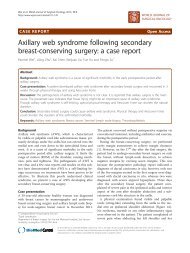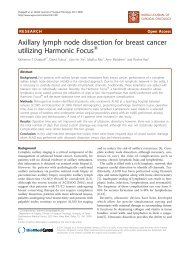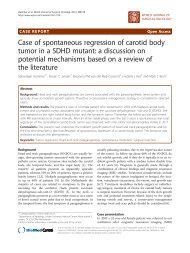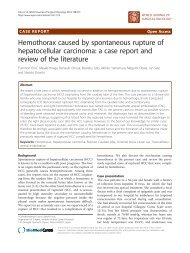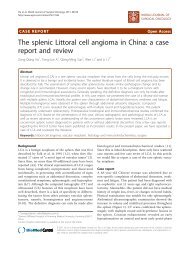Post-radiation sciatic neuropathy: a case report and review of the ...
Post-radiation sciatic neuropathy: a case report and review of the ...
Post-radiation sciatic neuropathy: a case report and review of the ...
You also want an ePaper? Increase the reach of your titles
YUMPU automatically turns print PDFs into web optimized ePapers that Google loves.
World Journal <strong>of</strong> Surgical Oncology 2008, 6:130http://www.wjso.com/content/6/1/130DiscussionPathophysiology <strong>and</strong> clinical courseVery little is known about <strong>the</strong> pathophysiology <strong>and</strong> <strong>the</strong>histopathological changes that occur in peripheral nervesafter <strong>the</strong>rapeutic ir<strong>radiation</strong>. Early experimental studiesindicated that <strong>the</strong> peripheral nerves are extremely radioresistant.However, <strong>the</strong> follow up time was short <strong>and</strong> it islikely that <strong>the</strong> injury did not have an opportunity todevelop [3].Today we know that post-ir<strong>radiation</strong> <strong>neuropathy</strong> occursboth directly <strong>and</strong> indirectly: directly by <strong>the</strong> harmful effect<strong>of</strong> <strong>the</strong> <strong>radiation</strong> on <strong>the</strong> nerve itself, <strong>and</strong> indirectly by <strong>the</strong>fibrosis that <strong>radiation</strong> causes in <strong>the</strong> tissue around <strong>the</strong>nerve [2].Direct effects <strong>of</strong> ir<strong>radiation</strong> on nerve include bioelectricalalterations (subnormal action potentials, altered conductiontime), enzyme changes, abnormal microtubuleassembly, altered vascular permeability <strong>and</strong> neurilemmaldamage. All <strong>of</strong> <strong>the</strong>se changes are observed experimentallywithin 2 days after ir<strong>radiation</strong> <strong>and</strong> are all dose dependent<strong>and</strong> irreversible [4-6].The secondary damage to <strong>the</strong> nerve is due to <strong>the</strong> extensivefibrosis <strong>of</strong> <strong>the</strong> connective tissue around <strong>the</strong> nerve, whichbecomes densely hyalinised. There is also a progressiveloss <strong>of</strong> elasticity <strong>and</strong> <strong>the</strong> development <strong>of</strong> contractures thatultimately consolidate <strong>the</strong> adjacent structures with <strong>the</strong>nerve. In addition, <strong>the</strong> decreased vascularity <strong>of</strong> <strong>the</strong> areamay destroy some adjacent peripheral nerves. Regeneration<strong>of</strong> <strong>the</strong> affected nerves may be impeded [2]. In a <strong>report</strong><strong>of</strong> findings at autopsy in two patients who had post-ir<strong>radiation</strong>brachial-plexus syndrome [7], varying degrees <strong>of</strong>fibrosis <strong>of</strong> <strong>the</strong> neurilemma, as well as demyelinization<strong>and</strong> fibrous replacement <strong>of</strong> <strong>the</strong> fibrils, were described.Mendes et al. in histological examination <strong>of</strong> femoral nervebranches removed during surgical decompression <strong>of</strong> <strong>the</strong>femoral nerve, in a patient with post-ir<strong>radiation</strong> femoral<strong>neuropathy</strong>, also found demyelinated nerve fibres surroundedby abundant scar tissue with areas <strong>of</strong> hyalinization[2].Peripheral nerve damage is a rare but underst<strong>and</strong>ablymajor complication <strong>of</strong> <strong>radiation</strong> <strong>the</strong>rapy associated withsignificant morbidity. The frequency <strong>of</strong> injury <strong>report</strong>edfrom some <strong>of</strong> <strong>the</strong> older studies is probably higher thanwould occur today as prior to <strong>the</strong> advent <strong>of</strong> CT <strong>and</strong> MRI,larger fields were used because <strong>of</strong> greater uncertaintyabout <strong>the</strong> dimensions <strong>of</strong> <strong>the</strong> tumour.In studies looking into post-ir<strong>radiation</strong> <strong>neuropathy</strong>involving <strong>the</strong> brachial <strong>and</strong> cervical plexuses after radio<strong>the</strong>rapyfor breast carcinoma it was found that symptomsgenerally begin within one to two years after treatment<strong>and</strong> are initially mainly sensory (e.g. burning pain, numbness,pares<strong>the</strong>sia) [7,8]. Any motor deficits that developare usually delayed for about eighteen months <strong>and</strong>include paresis <strong>of</strong> a group <strong>of</strong> muscles <strong>and</strong> complete paralysis<strong>of</strong> <strong>the</strong> arm [9]. Stoll et al. <strong>and</strong> Powell et al. have bothfound a direct relationship between <strong>the</strong> dosage <strong>of</strong> <strong>radiation</strong><strong>and</strong> <strong>the</strong> severity/time <strong>of</strong> appearance <strong>of</strong> symptoms[7,10].In a <strong>review</strong> <strong>of</strong> <strong>radiation</strong> injury to peripheral nerves publishedby Giese <strong>and</strong> Kinsella <strong>the</strong> authors conclude thatperipheral <strong>neuropathy</strong> is relatively infrequent at lowerdoses per fraction [11]. They expressed concern that c<strong>of</strong>actorssuch as radiosensitizers, chemo<strong>the</strong>rapeutic agents<strong>and</strong> surgical manipulations could possibly increase <strong>the</strong>incidence. Breast cancer patients receiving cytotoxic chemo<strong>the</strong>rapyhad a higher incidence <strong>of</strong> <strong>radiation</strong> induced brachialplexopathy compared to those having <strong>radiation</strong> onlyfollowing mastectomy [12].Any peripheral nerve may be affected by post-<strong>radiation</strong><strong>neuropathy</strong> <strong>and</strong> it is likely that <strong>the</strong> unique location <strong>of</strong> thistumour reflects 1) <strong>the</strong> special site <strong>of</strong> <strong>radiation</strong> <strong>the</strong>rapy <strong>and</strong>2) <strong>the</strong> repeated doses <strong>of</strong> <strong>radiation</strong> administered [12].Latency is an important factor to be considered when evaluatingnerve injury [12]. Stoll <strong>and</strong> Andrews did notobserve any <strong>neuropathy</strong> occurring before 5 months, witha majority occurring between 10 <strong>and</strong> 22 months after ir<strong>radiation</strong>.They also noted that <strong>the</strong> higher dose group didshow signs earlier than <strong>the</strong> lower dose group. Powell et al.did not observe any nerve injury prior to 10 months postir<strong>radiation</strong>,whereas <strong>report</strong>s exist in <strong>the</strong> literature <strong>of</strong> neuropathiesoccurring as late as 11 years after ir<strong>radiation</strong> forbreast cancer. Therefore, latency, as our <strong>case</strong> demonstrates,is a very important factor to be considered, sinceshort follow-up times may underestimate <strong>the</strong> true incidence<strong>of</strong> post-ir<strong>radiation</strong> injury to peripheral nerves.ManagementWhen considering management <strong>of</strong> post-ir<strong>radiation</strong>peripheral <strong>neuropathy</strong>, it is important to realise that anunalterable condition is <strong>the</strong> status <strong>of</strong> <strong>the</strong> patient's underlyingmalignancy prior to initiation <strong>of</strong> treatment, includingtumour size, location <strong>and</strong> structures involved/destroyed [12]. Fur<strong>the</strong>rmore, release <strong>of</strong> entrapped nervesfrom a fibrous mass can be challenging even for <strong>the</strong> mostskilled surgeon. Therefore, a short life expectancy coupledwith uncertainty <strong>of</strong> recovery from surgical interventionmake conservative management more appropriate.Also important in overall response to <strong>and</strong> recovery from<strong>the</strong>rapy is <strong>the</strong> general health <strong>of</strong> <strong>the</strong> patient <strong>and</strong>, if a child,<strong>the</strong> stage <strong>of</strong> development <strong>and</strong> growth [12]. If surgery is apart <strong>of</strong> <strong>the</strong> overall treatment, as was in our <strong>case</strong>, <strong>the</strong>n <strong>the</strong>Page 4 <strong>of</strong> 5(page number not for citation purposes)



